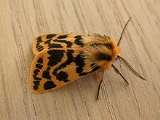
Spilosoma curvata
Encyclopedia
The Crimson Tiger Moth (Ardices curvata) is a moth
of the Arctiidae
family. It is found in Australia
. Formerly included in Spilosoma
, but later generic status of Ardices
was proved (Dubatolov, 2005).
The larvae feed on Taraxacum officinale
, Phaseolus vulgaris, Pelargonium zonale and Tropaeolum majus
.
Moth
A moth is an insect closely related to the butterfly, both being of the order Lepidoptera. Moths form the majority of this order; there are thought to be 150,000 to 250,000 different species of moth , with thousands of species yet to be described...
of the Arctiidae
Arctiidae
Arctiidae is a large and diverse family of moths with around 11,000 species found all over the world, including 6,000 neotropical species. This family includes the groups commonly known as tiger moths , which usually have bright colours, footmen , lichen moths and wasp moths...
family. It is found in Australia
Australia
Australia , officially the Commonwealth of Australia, is a country in the Southern Hemisphere comprising the mainland of the Australian continent, the island of Tasmania, and numerous smaller islands in the Indian and Pacific Oceans. It is the world's sixth-largest country by total area...
. Formerly included in Spilosoma
Spilosoma
Spilosoma is a genus of moths in the Arctiidae family. It is very heterogeneous genus, and needs in a serious review. Probably, some species should be separated into own genera.- Species more or less related to the type species :...
, but later generic status of Ardices
Ardices
Ardices is a genus of moth in the family Arctiidae from Australia.-Species::* Ardices canescens Butler, 1875* Ardices glatignyi -Subgenus Australemyra Dubatolov, 2005::* Ardices curvata...
was proved (Dubatolov, 2005).
The larvae feed on Taraxacum officinale
Taraxacum officinale
Taraxacum officinale, the common dandelion , is a herbaceous perennial plant of the family Asteraceae . It can be found growing in temperate regions of the world, in lawns, on roadsides, on disturbed banks and shores of water ways, and other areas with moist soils. T...
, Phaseolus vulgaris, Pelargonium zonale and Tropaeolum majus
Tropaeolum majus
Tropaeolum majus is a flowering plant in the family Tropaeolaceae, originating in South America in the Andes from Bolivia north to Colombia. It is of cultivated, probably hybrid origin, with possible parent species including T. minus, T. moritzianum, T. peltophorum, and T...
.

